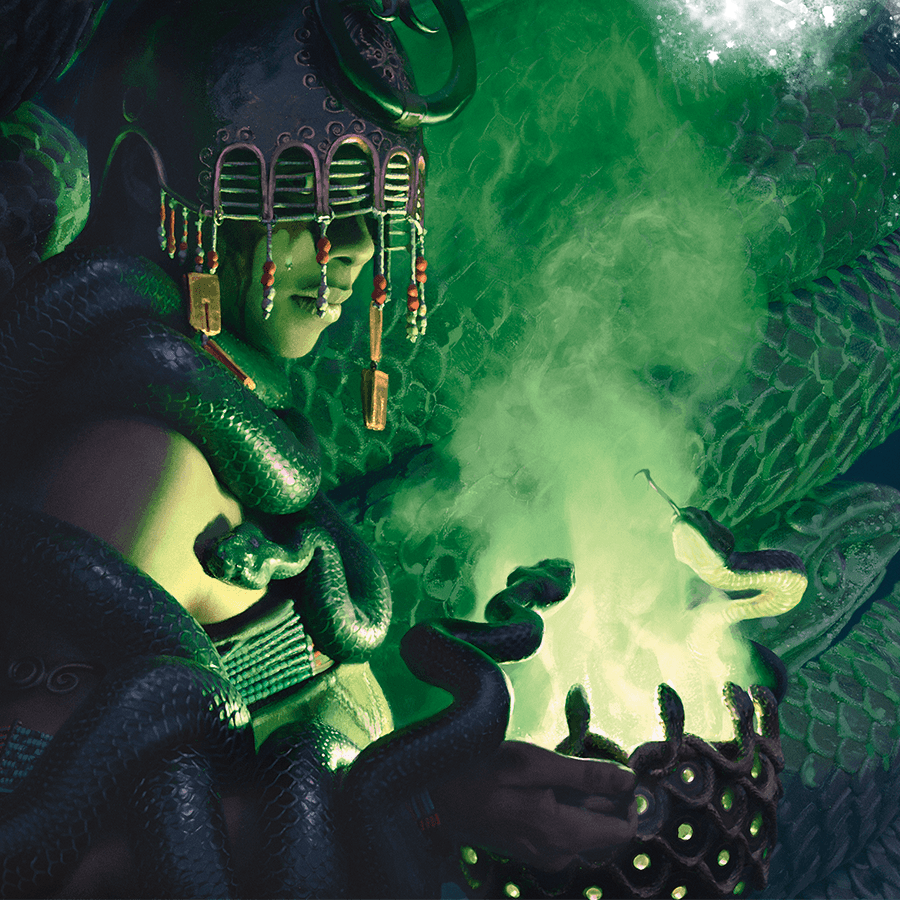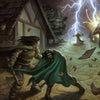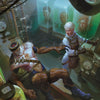How to Run “High-Stakes” Roleplaying in D&D

Written by Luke Hart
For many tabletop role-playing games, the game master and players spend most of their time engaged in social interactions—this is where the characters are talking to NPCs, commonly referred to as role-playing.
However, ironically enough, these social interactions, despite making up the vast majority of the game, are the parts that many game masters prepare for the least. I think that’s understandable. Many times, game masters may not be sure what they should prepare.
The other issue I see with social interactions is that we often use them as a sort of combat, where the characters try to coerce the NPC into doing something they probably don’t want to do. Now, there is nothing wrong with this sort of social interaction. I think that social combat could be an amazingly fun part of the game.
However, the issue is that we often resolve social combat with one die roll, usually a skill check. I think there is a solid case to be made that for some parts of the game, for some social interactions where they’re engaging in combat with words rather than weapons, we may want to use a more robust rule set to resolve it.
So, today, I will do two things in this article. First, I’ll discuss what a game master should prepare for an NPC that will be using social interactions in their game. You should ask yourself various questions while preparing an NPC for your game. If you answer these questions, you can run a much more satisfying and entertaining social interaction for you and your players.
The second thing I want to explain is the new social combat system my team and I created. You can use this social combat system when your players attempt to overcome an encounter with their social skills—their words—instead of weapons. Sometimes, resolving these high-stakes moments with just one skill check can feel unsatisfying. Also, it can be very swingy because success or failure hangs on one die roll. If they roll low, they fail; if they roll high, they might succeed.
Watch or listen to this article by clicking the video below.
Friendly vs. Hostile Social Interactions
The first thing we need to do is differentiate between friendly and hostile social interactions.
A friendly social interaction is when the characters interact with neutral or friendly NPCs, and their main objective is to obtain information; they might also want the NPCs to do something for them. This could be your standard NPC quest giver who delivers the plot hook and additional related information, or it might be a shopkeeper the characters attempt to barter with for a better price.
A hostile social interaction is exactly what it sounds like. It is a social interaction with an NPC who is antagonistic toward the characters. This often involves the bad guys who the characters are, or perhaps soon will be, fighting. However, it could also just be an NPC who opposes the characters for some reason. For instance, a noblewoman might have it in for the party and want to see them fail because they slighted her at a royal dinner party.
How to Build a Friendly Social Interaction
Now, we’re going to get into the meat of how to build these social interactions. For our purposes, we will assume that you have already created the NPC. They already have a name, a general description, an occupation, and perhaps even a secret.
When you anticipate that a specific NPC will be involved in a friendly social interaction, these are the questions you want to ask as you prepare.
#1 What relevant pieces of information does the NPC know? Note the emphasis on the word relevant here. These are things that pertain to the campaign, an adventure at hand, or something the characters might reasonably ask the NPC about.
#2 How can the characters get the NPC to divulge what they know? Of course, the NPC might just give it freely as well.
#3 Is the NPC withholding any information? If they are, what can the characters do to uncover that additional information?
#4 What can the characters do in this interaction that will change the NPC’s attitude toward them? This is particularly useful if the NPC is neutral and the characters attempt to get on their good side. It is also good to know what the characters might do that will cause a good relationship to sour.
You can usually answer these four questions in a couple sentences each. The longer and more complex the information you create, the more difficult it will be to use it in a social interaction. This is because social interactions are usually fast-paced, and you need to think and react to what your players’ characters are saying.
If you think your players are likely to ask an NPC to do something for them or give them something besides information, then it is helpful to ask some additional questions.
#1 What will the characters likely ask the NPC to do?
#2 What will motivate the NPC to give the characters what they want?
We have all been in games where the captain of the guard asks the players’ characters to help with a problem the town is experiencing. One of the very first questions the players ask is for the captain of the guard to help them resolve the problem. They might also ask for some soldiers to accompany them. Or, the characters might be shopping in the market, and one of the first things they try to do with the shopkeeper is get them to lower their prices.
Typically, you can do one of two things in these situations. You could just say no. Frankly, this is a perfectly fine response, though it is probably not super satisfying unless you have a very good justification. Or, you could lock the affirmative response behind a skill check. The characters make a Diplomacy check or an Intimidation check. If they are successful, the NPC does or gives them what they are asking for. However, this can also be unsatisfying in some instances.
The third option is to consider what would motivate the NPC to give the characters what they want. For instance, if the characters are asking for a month of free room and board at the tavern, which is a fairly tall ask, the tavern owner might be willing to give it if they go on a basic quest for him.
Or, if they are asking the captain of the guard to help them on a quest or lend them some soldiers, they may agree to it if the characters promise to give an equal share of the treasure, and if the soldiers die on the quest, the treasure is to go to their next of kin. Alternatively, the stipulation might be that if the soldiers die on the quest, the characters bring them back from the dead. After all, there’s a reason the captain of the guard is asking the characters to help with the issue and not just sending soldiers in the first place. It’s likely a very dangerous quest.
If the characters are trying to get the shopkeeper to lower their prices, the shopkeeper might have a small task for them to complete. They have a rival a few blocks over who has been sabotaging their business, and they would like the characters to return the favor.
You see when you have thought this through just a little bit and know what the NPCs might ask in return, you can enrich the game and make things more interesting than simply saying no or asking for a skill check.
How to Build a Hostile Social Interaction
I feel like sometimes we can be very intentional about friendly social interactions, but when it comes to hostile social interactions, game masters sometimes don’t put a lot of thought into them. They don’t do this for a couple of reasons.
First, several published modules just drop monsters into a room, and they don’t do anything but attack. The writers don’t give us any role-playing notes for those monsters or tell us what their motivations might be. They don’t give us any information with which we might inform a social interaction between the monsters and the players’ characters. This is a pet peeve of mine, and it’s exactly why my team includes role-playing notes for the various encounters in our publications.
Second, I have been in lots of games where game masters don’t do anything but have the monsters attack. It’s like you open a door, and the game master describes a pack of goblins in there and then tells you that they attack. There’s no opportunity whatsoever to overcome that encounter with any means other than combat.
I suggest that we, as game masters, be way more intentional about creating hostile social interactions. When enemies are in an area, we should also consider developing information that can help inform a social interaction. Many times, players want to talk to their enemies. They may want to use their social skills, Persuasion, or Intimidation skills to overcome that encounter. Not everything has to be combat.
So, when preparing an encounter, also be prepared for that encounter to be played out via a hostile social interaction. To do that, you want to consider the following:
#1 What will the characters likely want the NPCs to do? This might be surrendering to them, giving them an object, or anything else the characters might try to compel based on the nature of the adventure. For some hostile NPCs, the characters will likely want just one thing; for others, there may be a short list of possibilities.
#2 For each of the things the characters are likely to want the NPCs to do, describe how the characters can make that happen. It’s also acceptable to decide that there is no condition under which that would happen; I feel like this would be rather common when a major villain is ordered to surrender to the characters. A villain is just not going to surrender. It doesn’t matter if they make diplomacy checks and intimidation checks.
#3 List the relevant pieces of information the NPCs will know and describe how the characters can uncover it. Some of this information might be given freely, like how villains can monologue about their plans, but other pieces of information should only be available under certain conditions.
How to Run Social Combat
Now, most often, when characters try to compel an enemy to do something, the game master will ask for a skill check—Diplomacy, Intimidation, Deception, and the like. But getting a hostile enemy to do a thing with just one skill check seems a little far-fetched at times. Sure, it might work in some situations, but in others, it’s just not reasonable.
You could use a skill challenge instead, of course, which involves a series of skill checks. That’s perhaps a little more satisfying and reasonable. But it essentially just means making several skill checks instead of one, which might not be super interesting.
However, there is an alternative: social combat. When I say social combat, I mean just that—combat conducted socially through words and interactions instead of weapons.
My team and I created a streamlined system you can use to run social combat in your games. We also created versions of this for both D&D 5th edition and Pathfinder 2. I’ll walk you through the mechanics of the system. I’m going to get pretty granular, so if you’d like to use this system in your games, you can do so.
Now, if you’d like to save yourself the hassle of taking notes, we have also published this social combat system in Lair Magazine Issue 42, Society & Splendor. You can pick it up for either 5th edition, Pathfinder 2, or both. Also included in that issue are two adventures that use the social combat system and several other resources you can use in your games.
Now, social combat involves the highest stakes available in social interaction. It is a no-holds-barred, winner-take-all interaction where one side can compel the other in ways they cannot in an ordinary social interaction. These high-stakes standoffs can have consequences just as severe as combat, with the possibility of failure lurking around the corner.
The goal of social combat is to represent something between the standard cordial discussion and a fight to the death. Any group engaged in social interaction can declare the start of social combat. When the social combat begins, it uses the following rules.
#1 All creatures involved in the social combat roll initiative. Turns will play out in initiative order, but note that turns during social combat are not limited to the standard 6 seconds. The initiative primarily exists to keep the social combat orderly.
#2 Each creature begins the day with a morale of three plus its proficiency bonus. A group of creatures uses a single morale value, which I’ll share a bit later.
#3 On each turn, the creature chooses whether to make a Social Attack, Support an Ally, Prepare for an Incoming Social Attack, or use a standard action. I’ll go over what each of those means in just a moment.
#4 The Social Attack should be described or acted as something that would viably make the target creature back down; simply declaring a roll should not be sufficient. In other words, if the rogue is good at Stealth, they can’t simply say they are using Stealth for a roll. They need to explain how that would actually be relevant in the social combat.
#5 If a Social Attack is successful, it inflicts morale damage, reducing the target creature’s morale by 1. Morale damage increases to 1d4 at level 5, 1d4 + Charisma modifier at level 10, and finally to 2d4 + Charisma modifier at level 17. A roll of a natural 20 always increases the morale damage by a flat 1 point.
#6 A creature or group of creatures cannot use the same action twice in a row except for making a Social Attack.
#7 When a creature or group of creatures’ morale is reduced to 0, it becomes frightened of the other side for 24 hours. While frightened in this way, the creature can move toward the creature it is frightened of at half its movement speed. This outcome is separate from winning or losing the social combat overall. One or more creatures or groups of creatures can be reduced to 0 morale without their side losing the entire social combat.
#8 After the social combat ends, players can restore their morale by using hit dice during a short rest (one morale point per hit die expended) or by completing a long rest.
OK, now I’ll go over some of the game mechanics that are specific to the social combat system.
First, we have Social Attack. A Social Attack is made using any Charisma-based skill as long as the creature can justify its use. The result of this rule must equal or exceed the target’s social AC to be successful.
That brings us to the social AC. A creature’s social AC is equal to their choice of 10 + the creature’s Wisdom (Insight) modifier or 10 + Charisma (Intimidation) modifier. Each creature must designate which option it will use at the beginning of the social combat. At the game master’s discretion, the creature can use Strength (Intimidation) in place of any Charisma (Intimidation) check. Creatures with high Wisdom or Charisma modifiers (12 or above) should be assumed to be proficient with Insight or Intimidation for the purposes of determining their social AC; that is, they should include their proficiency bonus when determining their social AC.
Next, we have Support an Ally. When supporting an ally, the creature chooses any applicable skill and rolls to determine a result. If the supported creature makes a Social Attack on its turn, it may choose to use the result of its supporter’s roll in place of its own. Again, we have the same stipulation against applicable skills insomuch that they must make sense in the context of the situation.
The next mechanic is to Prepare for an Incoming Social Attack. With this, the creature prepares for whatever is coming and steels its nerves. This grants it a + 2 social AC bonus until the start of its next turn.
Finally, we have standard actions. These include anything on a character sheet or stat block. Depending on the action taken, social combat may devolve into standard combat. Alternatively, spellcasting, Bardic Inspiration, and other options could enhance allies as an alternative to using the Support an Ally action.
In the base social combat system, we assume that every creature involved in the combat can take its own individual actions on its initiative. However, you may want to group up NPCs or monsters. When you combine NPCs or enemies into groups, the social combat will probably move a bit faster. When in a group of two or more, NPCs and monsters benefit from the following group bonuses:
#1 A group’s social AC is equal to the highest individual social AC of the creatures in the group, and the group receives a +1 bonus to their social AC for every three creatures in the group.
#2 The group has a Social Attack modifier equal to the highest individual Social Attack modifier of the creatures in the group, and the group receives a +1 Social Attack bonus for every three creatures in the group.
#3 The group’s morale value is equal to the highest individual morale of the creatures when they start the combat. Groups of monsters have a +1 bonus to morale for every three group members.
So, those are the mechanics for conducting social combat. However, how do you win or lose? A side loses a social combat when the morale of all of its individual members or groups has been reduced to 0; much like during normal combat, a side loses when all of its members are reduced to zero hit points.
The results of winning or losing social combat differ slightly from winning or losing standard combat. First of all, nobody usually gets killed during social combat. In fact, the goal is to not even use weapons.
In general, once one of the sides participating in the social combat loses, its members are compelled to retreat from the social combat and cannot initiate either physical or social combat against the winning side for 24 hours. However, the losing side may fight back if either physical or social combat is initiated against them.
Retreating from social combat does not necessarily mean fleeing the area. The intent is that winning social combat effectively neutralizes the threat and overcomes the challenge of the losing side.
When you’re designing a social combat encounter, consider what the expected outcome will be beyond just retreating. For instance, if the characters win the social combat, what do they get? Do they get something besides just not having to have physical combat? Can they compel the creatures that lost to act in a certain way? Or might they be able to get them to flee from the area without further fighting?
For example, in the level 18 adventure included in Issue 42 of Lair Magazine, the vampire, Armand, can be fought in social combat to compel him to help the characters reach the rear of the temple.
Now, I certainly do not think you should use this social combat system in every circumstance. There are certainly times when a simple skill check is all you need. However, if you’re looking to simulate a high-stakes social interaction where something of great value hangs in the balance, this social combat system was designed to do just that.
Social Encounters: Making Social Interaction Exciting!
If you want to improve high-stakes social interactions in your games, you can get the social combat system in the DM Lair store with Lair Magazine #42, Society & Splendor.
This system includes everything you need to run friendly and hostile social interactions.
-
Posted in
Game Master How-To Articles







